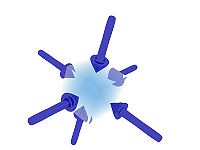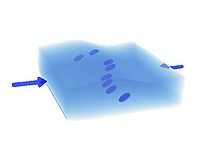
Fault mechanics
Encyclopedia

Geologic fault
In geology, a fault is a planar fracture or discontinuity in a volume of rock, across which there has been significant displacement along the fractures as a result of earth movement. Large faults within the Earth's crust result from the action of tectonic forces...
s.
Behind every good earthquake
Earthquake
An earthquake is the result of a sudden release of energy in the Earth's crust that creates seismic waves. The seismicity, seismism or seismic activity of an area refers to the frequency, type and size of earthquakes experienced over a period of time...
is some weak rock. Whether the rock remains weak becomes an important point in determining the potential for bigger earthquakes.
On a small scale, fractured rock behaves essentially the same throughout the world, in that the angle of friction is more or less uniform (see Fault friction
Fault friction
Fault friction describes the relation of friction to fault mechanics. Rock failure and associated earthquakes are very much a fractal operation . The process remains scale-invariant down to the smallest crystal...
). A small element of rock in a larger mass responds to stress
Stress (physics)
In continuum mechanics, stress is a measure of the internal forces acting within a deformable body. Quantitatively, it is a measure of the average force per unit area of a surface within the body on which internal forces act. These internal forces are a reaction to external forces applied on the body...
changes in a well defined manner: if it is squeezed by differential stresses greater than its strength, it is capable of large deformations. A band of weak, fractured rock in a competent mass, can deform to resemble a classic geologic fault
Geologic fault
In geology, a fault is a planar fracture or discontinuity in a volume of rock, across which there has been significant displacement along the fractures as a result of earth movement. Large faults within the Earth's crust result from the action of tectonic forces...
. Using seismometer
Seismometer
Seismometers are instruments that measure motions of the ground, including those of seismic waves generated by earthquakes, volcanic eruptions, and other seismic sources...
s and earthquake location
Earthquake location
The primary purpose of a seismometer is to locate the initiating points of earthquake epicenters. The secondary purpose, of determining the 'size' or Moment magnitude scale must be calculated after the precise location is known....
, the requisite pattern of micro-earthquakes can be observed.

Interplate earthquake
An interplate earthquake is an earthquake that occurs at the boundary between two tectonic plates. If one plate is trying to move past the other, they will be locked until sufficient stress builds up to cause the plates to slip relative to each other...
s, by the motion of tectonic plates. Under a following force, the seismic displacements eventually form a topographic feature, such as a mountain range.

In fact, the seismic zone (such as the New Madrid Fault Zone) is ensured eternal life, by the action of water. As shown, if we add the equivalent of a giant funnel to the crack, it becomes the beneficiary of stress corrosion (the progressive weakening of the crack edge by water) http://www.nire.go.jp/annual/1998/28.htm . If there is a continuing supply of new water, the system does not come to equilibrium, but continues to grow, ever relieving stress from a larger and larger volume.

Permeability (fluid)
Permeability in fluid mechanics and the earth sciences is a measure of the ability of a porous material to allow fluids to pass through it.- Units :...
), and the usual high horizontal interior stresses of the rock mass. All small earthquake zones have the potential to grow up to be like New Madrid or Charlevoix .http://www.seismo.nrcan.gc.ca/historic_eq/charpage_e.php.

